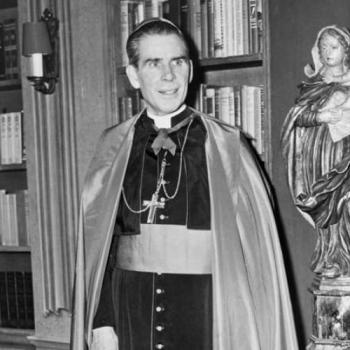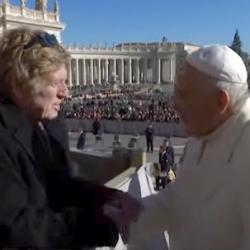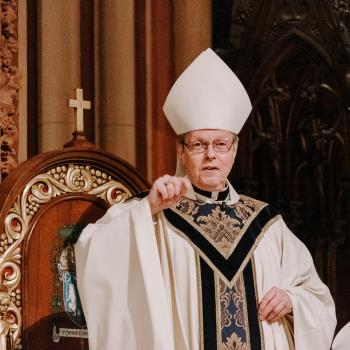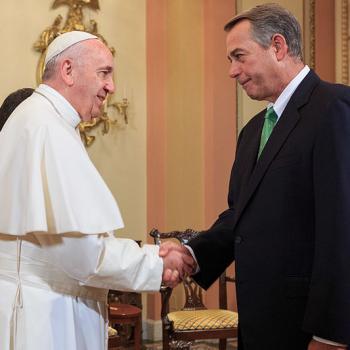That’s the question on the lips of a lot of Vatican-watchers, including Francis X. Rocca at Catholic News Service:
As he moves beyond words and gestures to the stage of substantive actions, no decision that Pope Francis makes will be of greater consequence for reform of the church’s bureaucracy than his choice of a secretary of state, the Vatican’s highest official, who oversees both the internal affairs of the Holy See and its relations with 180 other states.
Having filled that role for most of the previous pontificate, Cardinal Tarcisio Bertone has drawn most of the blame from outside critics for dysfunction within the Roman Curia. Whether or not the criticism is entirely fair, the cardinal is bound to step down soon, if only because he is already three years past the standard retirement age of 75.
Pope Francis, who has shown himself ready to defy precedent and conventional wisdom at least in matters of protocol, could, in principle, replace Cardinal Bertone with just about anyone. Nevertheless, since the new pope is from Latin America and has never studied or worked in Rome, he is likely to choose someone who shares the Italian nationality of the vast majority of the Vatican’s staff and who has some experience working inside its bureaucracy.
Yet choosing an insider presents obvious problems for reform, if nothing else because a Vatican resume would clash symbolically with any process of renewal. Hence the difficulty with two otherwise well-qualified and oft-mentioned possibilities: Cardinal Giuseppe Bertello, president of the commission governing Vatican City State; and Cardinal Fernando Filoni, prefect of the Congregation for the Evangelization of Peoples, who served under Cardinal Bertone for four years as the “substitute” in charge of the church’s internal affairs.
One name mentioned as a possible secretary of state even before Pope Benedict’s resignation was that of Cardinal Mauro Piacenza, prefect of the Congregation for Clergy, a man widely admired for his personal integrity and evident devotion. But his collapse in St. Peter’s Square during Palm Sunday Mass March 24, and his subsequent hospitalization for reported heart problems, hardly argue for his appointment to the stressful job of administrative reformer.
Hence the appeal of a choice that would have been almost unthinkable just weeks ago: someone with high-level experience in both the Vatican administration and its diplomatic corps, and who has shown himself ready to make enemies in the cause of reform.
That would be Archbishop Carlo Maria Vigano, formerly the second-highest official in Vatican City State, who wrote to Pope Benedict in early 2011, warning of “corruption and abuse of power long rooted in the various departments” of Vatican City and criticizing the inexperience of advisers who he said had led the Vatican to lose millions of dollars in bad investments. Pope Benedict named the archbishop nuncio to the United States in October 2011, and he remains in that position today.
When Archbishop Vigano’s charges were published in early 2012, two cardinals took the unusual step of publicly rebuking him for his “erroneous evaluations” and “fears unsupported by proof” — reactions of a kind that ordinarily do not favor one’s rise in the hierarchy. But under a pope who has shown himself more than willing to disturb the status quo, the archbishop’s notoriety may turn out to be his biggest recommendation.
Meantime, Arthur Jones over at the National Catholic Reporter, takes a look at some other key jobs that need to be filled:
A large number of poorer countries are predominantly Muslim. A friend of mine suggests that one way Francis could change the face of evangelization is to send all the bishops who have titular sees in North Africa over to North Africa to start their evangelizing in their other dioceses.
Further, Francis, if he wants to improve the church’s influence in key areas of the world, could run his finger down a list of the world’s 100 largest cities. He would see that Tokyo, with more than 13 million people, has no cardinal, while Malta, with 400,000 inhabitants, had one.
Rearranging the seating at the conclave table, however, is casting the curial reform into the future. Closer at hand, what to watch for is Francis’ handling of two key congregations: the Congregation for Bishops and the Congregation for the Doctrine of the Faith.
If Francis wants a caring church, he will have to see that caring bishops, pastoral men with simple lifestyles, are appointed. Unless he changes the system for the selection of bishop candidates — by opening it up to wider consultation — then the type of men in line to be cardinals doesn’t change.
Currently, given the appointments of the past three decades, he doesn’t have a large pool of compassionate pastor-types to draw from.
Which further means the type of men in line to be papabile doesn’t change either, and the church returns to the old curial control.











